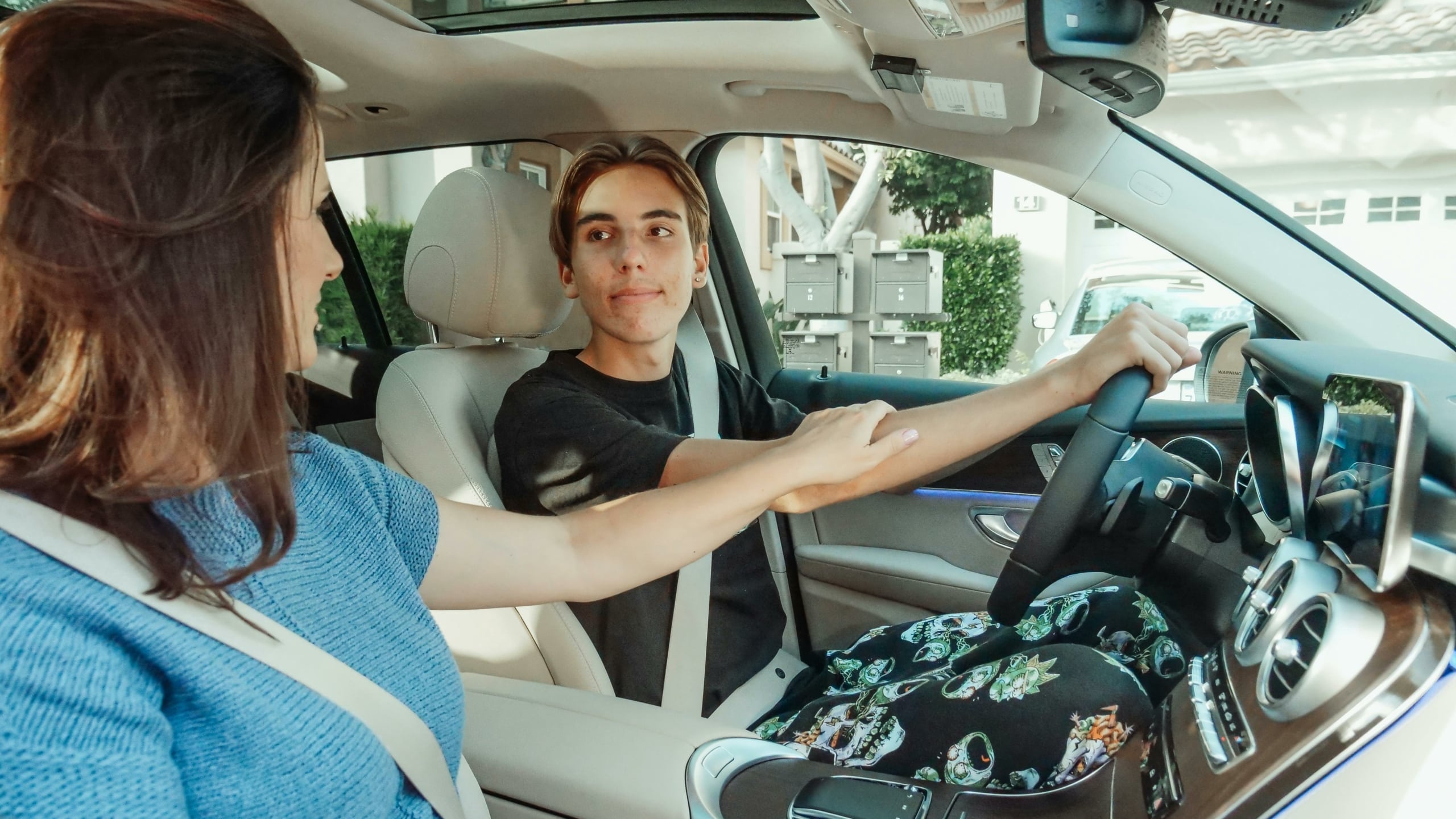
Learning to drive can be an empowering experience, but many new drivers are faced with anxiety when they get behind the wheel. If you’re feeling anxious while driving, it’s critical to first understand where your anxieties are coming from so you can begin to address them to feel safe on the road.
In this guide, we’ll help you understand the causes of driving anxiety, explore practical strategies to manage it, and show you how professional guidance can build confidence.
The truth is, while driving anxiety is common, it’s not always caused by the same thing in every individual. Driving anxiety may stem from different common causes, such as:
- Fear of accidents
- Making mistakes on the road
- Being exposed to anxious driving behaviors from family members
- Past negative experiences in or with vehicles
- Beginning to drive later in life, when one may have less familiarity with driving responsibilities
- Generalized anxiety disorders or pre-existing stress
The good news is that once you have an understanding of the root cause of your own driving anxiety, you can begin to take steps to manage and correct it and build confidence on the road. For more detailed insights into common causes of driving anxiety, we recommend you read a comprehensive article on overcoming the fear of driving by the Anxiety and Depression Association of America.
Strategies for Managing Driving Anxiety
New drivers can use a variety of different strategies and techniques to effectively manage their driving anxiety. There are several strategies that can reduce anxiety and build confidence:
- Relaxation techniques
- Cognitive behavioral strategies (CBT)
- Tapping (Emotional Freedom Technique)
- Gradual exposure to driving situations
If you’re unfamiliar with these techniques, we recommend practicing them first with the guidance of a mental health counselor or trusted sources so you can get comfortable with them in advance.
Relaxation Techniques for Managing Driving Anxiety
There are multiple relaxation techniques that can improve focus on the road, such as:
- Deep breathing exercises before and during driving
- Progressive muscle relaxation to release tension
- Mindfulness or grounding exercises to stay present
Adding these routines to pre-driving preparation can significantly reduce anxiety by retraining your nervous system to relax while in a vehicle.
10 Minutes of Focused Attention: A Quick Exercise to Calm an Anxious Mind
Cognitive Behavioral Strategies for Overcoming Driving Anxiety
Cognitive Behavioral Therapy (CBT) offers valuable tools for reframing negative thought patterns and challenging irrational beliefs associated with driving anxiety. CBT can help new drivers develop healthier ways of thinking so that they can build resilience on the road. Here’s how it can help:
- Identify thoughts that increase driving fear
- Challenge panic triggers with realistic alternatives
- Practice coping strategies to build confidence over time
- Expose yourself to controlled driving situations
With the help of a therapist trained in CBT methods, you can overcome specific driving anxieties through consistent exposure and learning new behaviors to replace old patterns.
Tapping
Tapping, also known as Emotional Freedom Technique (EFT), is a holistic healing method that combines ancient Chinese acupressure and modern psychology. The goal of tapping techniques is to release emotional blockages by tapping on specific points of the body. There are a lot of benefits to tapping for driving anxiety, such as:
- Helps release tension associated with driving anxiety
- Calms the nervous system and promotes focus
- Brings awareness to physical stress in the body
Tapping techniques work best when you name specific driving fears while doing so. This brings awareness to specific anxieties or phobias so you can target them with mindful tapping exercises.
Exposure Therapy and Gradual Exposure Techniques
Exposure therapy involves gradually exposing yourself to feared situations or stimuli in a controlled environment. There are a few ways to expose yourself to your different anxiety triggers gradually:
- Start in low-stress environments like quiet streets or empty lots
- Incrementally increase distance, traffic, or complexity
- Repeat each step until you feel more comfortable
The key to exposure techniques is to practice them regularly. You’re not going to feel calmer after doing something stressful once or twice, but the repeated pattern of exposure is what helps reframe your anxieties and reduce fear over time.
Tips for New Drivers to Stay Calm and Focused on the Road
We like to think we’re in control when we drive. The truth is, we can be. Aside from the techniques we covered above, there are a few more tips you can implement to make driving a more pleasant experience.
Take note of the tips below and try new ones to see what works for you, or download the entire table to keep with you as a reminder.
| Technique | Tip | When to Use | How It Helps |
| Breathing | Practice deep breathing exercises (4-7-8 technique: inhale 4, hold 7, exhale 8) | Before and during driving | Activates relaxation response, reduces heart rate |
| Task management | Break down driving tasks into manageable steps | During complex maneuvers or new situations | Prevents overwhelm, improves focus |
| Mental preparation | Use positive affirmations and visualization | Before driving sessions | Builds confidence, reframes negative thoughts |
| Environment Control | Start with familiar, low-traffic routes | Early practice sessions | Reduces external stressors while building skills |
| Music and sound | Play calming music or silence notifications | During driving | Minimizes distractions, creates a peaceful atmosphere |
| Time management | Leave extra time for trips to avoid rushing | Planning stage | Reduces pressure and panic about being late |
| Post-drive reflection | Journal or note what went well after each drive | After driving sessions | Reinforces progress, identifies patterns |
| Emergency planning | Know your route and have a backup plan | Planning stage | Provides a sense of control and preparedness |
Check out our expert guide for additional tips on building confidence as a first-time driver.
The Role of Support Systems and Coping Mechanisms
Building a strong support system and utilizing effective coping mechanisms are essential for managing driving anxiety. There’s more than one way to build a support system, so figure out the people or activities that best help you cope and lean into them. Some support systems and coping mechanisms include:
- Seeking guidance from experienced drivers, such as friends, family members, or driving professionals
- Enrolling in a driving course to master driving skills
- Practicing self-care activities before and after driving to create a calm around your experiences
- Work with a counselor or therapist who can help you manage anxiety in your daily life and while driving
Seeking Professional Help for Driving Anxiety
About 10% of American adults experience some form of anxiety in their lives. For some, this can manifest as driving anxiety. While self-help strategies can be beneficial, individuals experiencing severe or persistent driving anxiety may benefit from seeking professional help, and that’s nothing to be ashamed of. In fact, it can make a dramatic difference in improving your anxiety.
There are several benefits to seeking professional help to manage your driving anxiety. Let’s look at a few reasons.
Personalized coping plan
Some techniques or coping mechanisms may feel like they’re one-size-fits-all, and they don’t necessarily work for everybody. A professional, like a therapist or counselor, can create a personalized plan to understand, manage, and move past your driving fears in a safe and approachable way.
Quicker results
Applying different strategies on your own can be a help to some drivers, but some people need more of a plan. Combining therapy with ongoing driving practice and exposure can help you see results quicker than doing it on your own.
Feel safe and more confident
The guidance of a professional can help you feel safer and more confident behind the wheel. This is especially true when you work with both a therapist and a driving instructor in tandem. The professionals can work together to address your specific driving anxieties and create a plan to help you overcome them.
How Driven2Drive Builds Confidence in New Drivers
At Driven2Drive, we understand the importance of addressing driving anxiety and empowering new drivers to feel confident on the road. Our comprehensive driving programs focus not only on teaching essential driving skills but also on building confidence and resilience in our students. Hear from our students directly.
We offer personalized lessons tailored to each student’s needs so that they can get hands-on practice in a supportive, patient environment. Driven2Drive’s professional instructors always encourage communication around your anxiety to help address specific challenges, and our lessons are structured to give students both driving skills and confidence.
FAQs
What causes anxiety in driving?
Various factors can cause anxiety in driving, such as fear of accidents, traffic congestion, or unfamiliar routes. Age can be a factor, too. Sometimes, for new drivers, the more familiar you are with driving, the less anxious you feel. Often, anxieties return in older age, and you must work again to overcome your fears.
How can I manage anxiety while driving?
Anxiety while driving can be managed through relaxation techniques, cognitive behavioral strategies, and gradual exposure therapy. Breathe, slow down, and talk yourself through it to help your body relax.
What tips can help new drivers overcome anxiety behind the wheel?
New drivers can overcome anxiety by staying calm and focused, relying on support systems, and practicing coping mechanisms. You’ve got this.
When should I consider seeking professional help for driving anxiety?
Seeking professional help for driving anxiety is advisable if it significantly affects daily life or if self-help strategies are ineffective.
Are there any brand-specific strategies for building confidence in new drivers?
Specific driving schools like Driven2Drive may offer a unique approach or method to achieve strategies for building confidence in new drivers, emphasizing personalized instruction and hands-on experience. We enhance your learning to build confidence in new drivers.
References:
- Anxiety disorders – Symptoms and causes – Mayo Clinic
- Overcoming the Fear of Driving | Anxiety and Depression Association of America, ADAA
- EFT Tapping: What Is It and Does It Work for Stress?
- What Is Exposure Therapy?

Ronit Tehrani is the Founder and Co-Owner of Driven2Drive, a premier driving and license testing center in Philadelphia. Since 2013, she has been dedicated to providing safe driving education and skills for lifelong success. Under her leadership, Driven2Drive became Pennsylvania’s first privately owned PennDOT-certified testing center, now with six locations.
